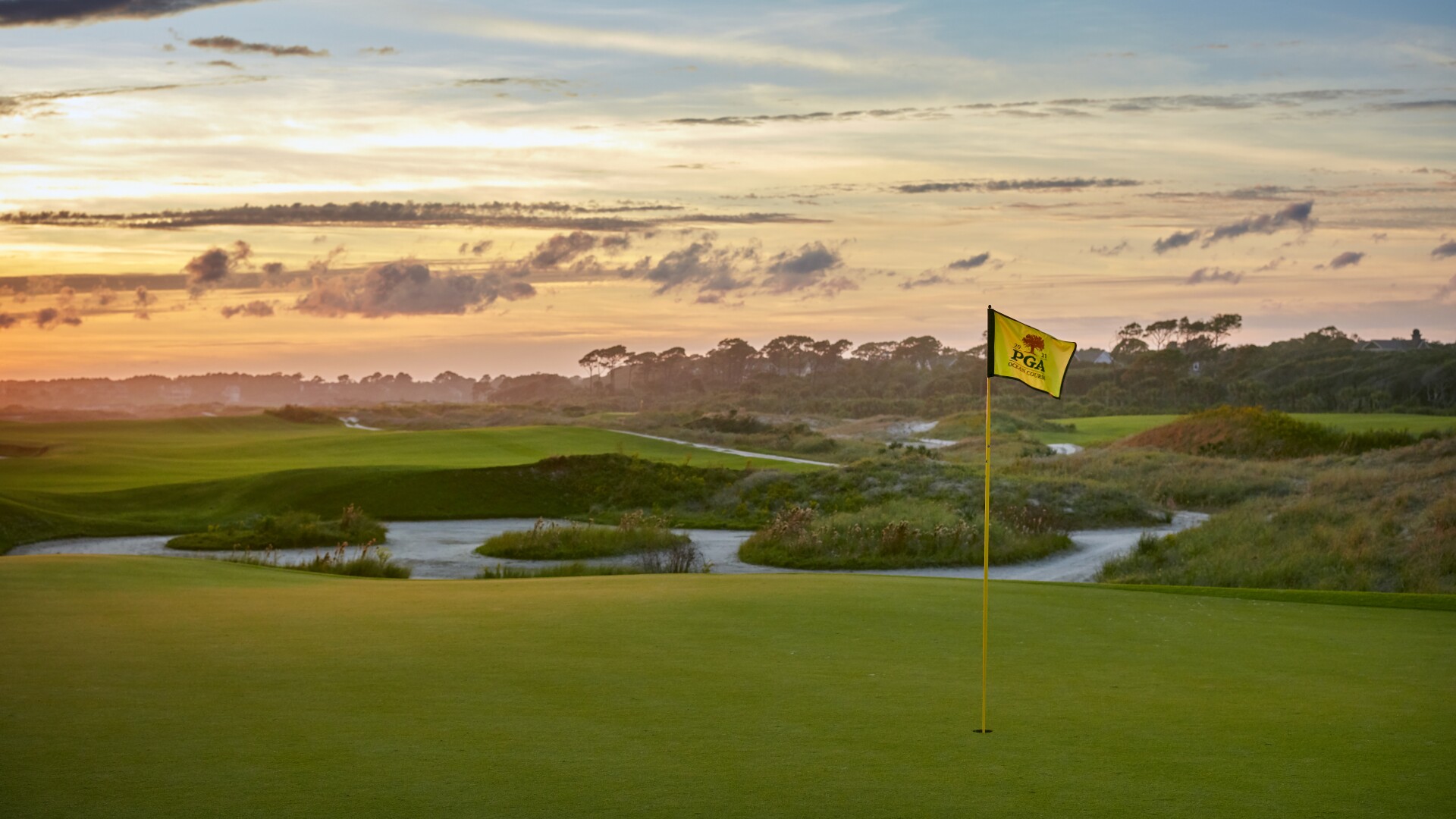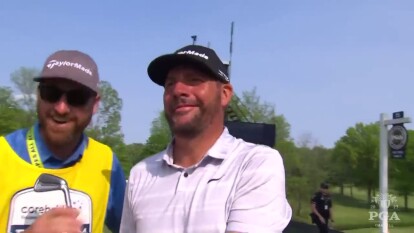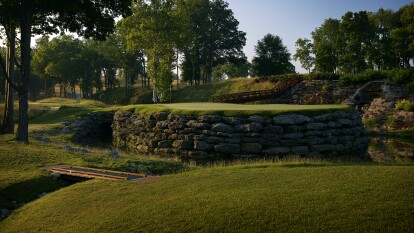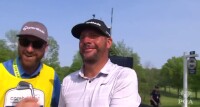The Ocean Course is alive.
That’s what Pete Dye would tell Brian Gerard as together they walked the course Dye designed beside the Atlantic Ocean.
“Pete always says this golf course walks. It swims. It moves because of the winds and where it's sitting,” said Gerard, the Director of Golf at Kiawah Island Golf Resort. “Things kind of move and change a little bit.”
Those walks with Dye are some of Gerard’s most prized memories during his more than 35 years spent working at the resort, which this week hosts the PGA Championship for the first time since 2012. Gerard’s long history with the venue and the invaluable time he spent with its architect has given Gerard a unique opportunity to maintain Dye’s legacy and the original design of the Ocean Course.
Gerard first came to the property as an intern in 1986. He climbed the ranks to Assistant Golf Professional, then Head Professional, and now into his current role as Director of Golf. Gerard has been around Kiawah longer than the Ocean Course, which was constructed by Pete and Alice Dye in just two short years between 1989 and 1991. It was the first time a Ryder Cup had been awarded to a course that hadn’t yet been created.
Gerard can recall the first time stepping foot on to what would later become the Ocean Course. At the time there was no road, no clubhouse and no golf course, but there was an access path he was able to walk on alongside what would later become the 14th tee. The course hadn’t yet been routed, but he can remember the wind howling off the ocean, whipping across his face and the unbelievable feeling of being exposed to the elements. The views were unforgettable which was a credit to Alice, who suggested the 10th, 11th and 12th holes be elevated to allow for views of the ocean over the inward holes, 14 through 18.
“I always remember the first time I saw it,” Gerard said by phone from South Carolina. “I wish I would have had the opportunity to spend more time with Pete when he was building the golf course because that would have been amazing.”
Gerard was an Assistant Golf Professional during the course’s construction. Back then, he didn’t have day to day interactions with the Dyes but as Gerard climbed the ranks at Kiawah Island Golf Resort he began spending more time with Pete, who would visit the course a few times each year. Often unannounced. Gerard recalls Dye calling to let him know he’d be visiting. When Gerard asked Dye where he was, he said he was walking into the clubhouse.
“He came in and said, ‘Brian Gerard. Pete Dye. Let’s go out and take a walk,’” said the Director of Golf, remembering the first time he met the famed golf course architect.
“I’m thinking to myself, ‘Okay, I’m walking the golf course with Pete Dye,’” Gerard said about what was, at first, an intimidating experience. “He was so genuine. It was a matter of a couple minutes and I felt very comfortable just the way that he would talk to me and ask me questions.”
Gerard remains committed to maintaining the original design the Dyes laid out 30 years ago, so very few changes have been made since the PGA Championship was first played on the Ocean Course in 2012. Back tees were added to holes six, nine, 12, 15 and 18. Trees were restored on four holes, which led to what is likely the most noticeable change with the replacement of what had been nicknamed the “Rory Tree.”
During the third round of the 2012 PGA Championship, Rory McIlroy lost his ball in a tree at the par 4, third hole. In 2012, the live oak was already without leaves and died a few years after the Championship. It needed to be replaced. In 2019, Gerard and his team reviewed footage from the Championship and looked at photographs from when the course was first built to find another tree that was nearly identical in order for it to be planted in the exact location of the original tree.
“We wanted to keep the integrity of the original design,” Gerard explained about their search for a new tree. But it wasn’t an easy task. The “Rory Tree” had an unusual shape, with large v-shaped branches that shot off in multiple directions. It’s no wonder it swallowed McIlroy’s ball.
“We easily could have said, 'Let's put the tree back, let’s move the tree over here a little bit.’ We didn’t want to do that,” said Gerard. “It was very important to us to maintain what Pete had built here and we thought it was the right thing to do.”
The team found a replacement tree on the property at Kiawah Island Golf Resort. The same strategy was used to replace three other trees that had died since the 2012 PGA Championship. Additionally, a waste area was restored at the par 5 seventh hole that had changed along the perimeter due to high winds and sand blow. It was returned to Dye’s original layout.
“The design, the ambience, the characteristics of this golf course are something we want to maintain through time,” Gerard said. “I don't think we want to go in and change anything.”
Other than the addition of a few tee boxes, replacement of four trees and a restored waste area, the layout that players encountered during the 2012 PGA Championship will be very much the same in 2021. Gerard says no other changes have been made to the Ocean Course.
And the team that hosted the Championship nine years ago hasn’t changed much either. Half a dozen of the Championship co-chairs that were in place when the resort first hosted the PGA Championship have returned. The sheer experience of having hosted the Championship before has been invaluable to Gerard and his team as they’ve spent the last six years preparing for its return.
“Everything associated with a PGA Championship was the biggest eye opener for me,” Gerard said about 2012. “You don’t really understand and grasp the magnitude of what actually happens until you go through it.”
Gerard says one of the biggest changes, from 2012, has been the increased media attention. He’s done countless more interviews, podcast appearances and fielded significantly more media requests than he did nine years ago. But he enjoys it. It’s an opportunity for him to share the experience of a life, more than three decades, spent at Kiawah Island Golf Resort.
“I’m very blessed in that regard that things have worked out the way they have for me in my life.”
As Gerard has given more interviews in the lead up to this year’s PGA Championship, he’s often thought back on his walks with Pete Dye, which have come to mean even more to him now that both Pete and Alice have passed. Pete died in January of 2020 and Alice the year prior.
“I’ve started to realize just how special those moments were 25 years later, and it’s really cool to reflect on those times,” Gerard said about his time with Pete. “They were limited for me, but still very special.”
Pete would remind the Director of Golf that the Ocean Course was alive. It would walk and swim and move depending on where the wind would blow it. This week, the world’s best players will descend once again on its shores, ready to be tested by the course that Dye brought to life and Gerard has dedicated his career to nurturing.





